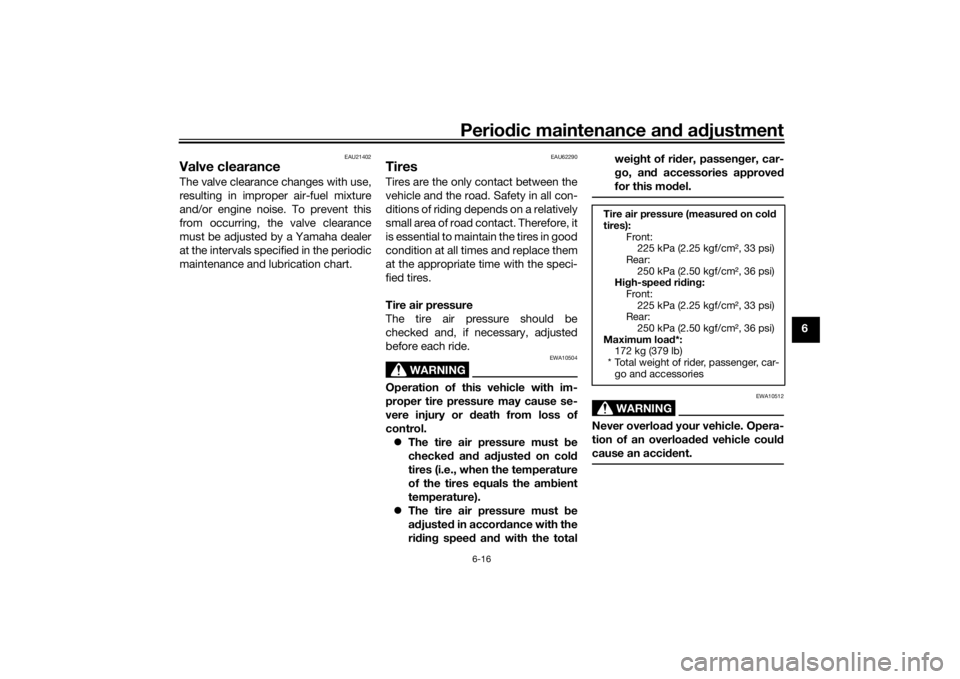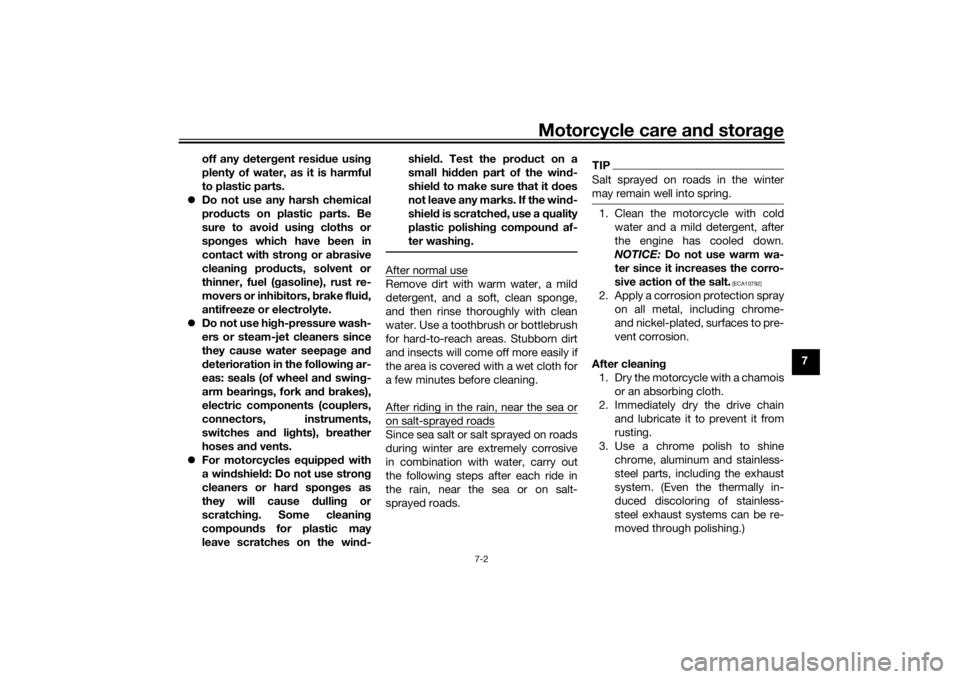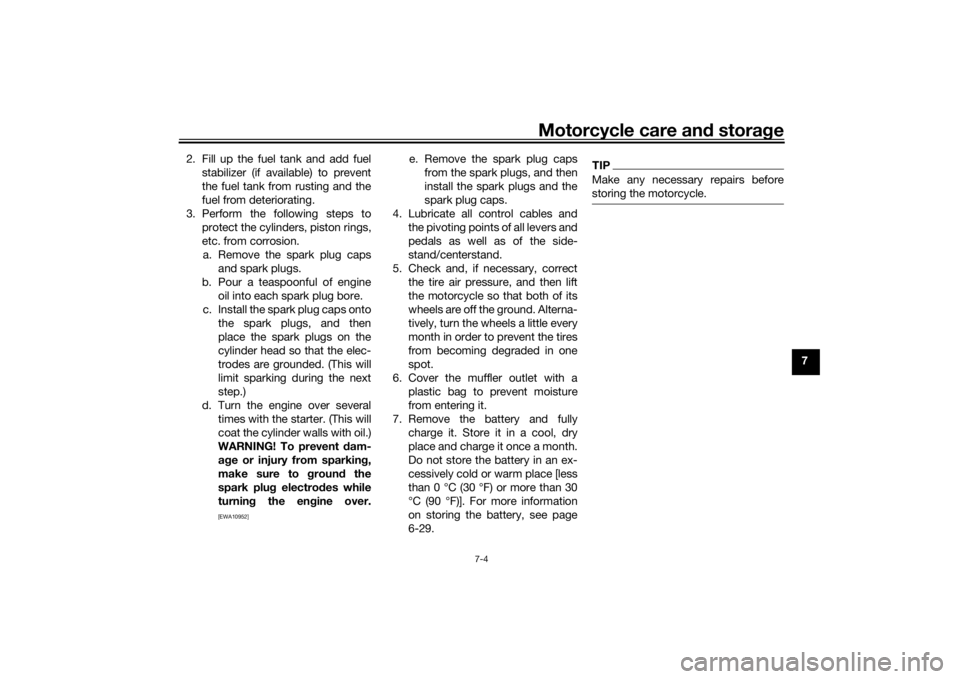fuel pressure YAMAHA XSR 700 2017 Owners Manual
[x] Cancel search | Manufacturer: YAMAHA, Model Year: 2017, Model line: XSR 700, Model: YAMAHA XSR 700 2017Pages: 100, PDF Size: 7.24 MB
Page 63 of 100

Periodic maintenance and adjustment
6-16
6
EAU21402
Valve clearanceThe valve clearance changes with use,
resulting in improper air-fuel mixture
and/or engine noise. To prevent this
from occurring, the valve clearance
must be adjusted by a Yamaha dealer
at the intervals specified in the periodic
maintenance and lubrication chart.
EAU62290
TiresTires are the only contact between the
vehicle and the road. Safety in all con-
ditions of riding depends on a relatively
small area of road contact. Therefore, it
is essential to maintain the tires in good
condition at all times and replace them
at the appropriate time with the speci-
fied tires.
Tire air pressure
The tire air pressure should be
checked and, if necessary, adjusted
before each ride.
WARNING
EWA10504
Operation of this vehicle with im-
proper tire pressure may cause se-
vere injury or death from loss of
control.
The tire air pressure must be
checked and adjusted on cold
tires (i.e., when the temperature
of the tires equals the ambient
temperature).
The tire air pressure must be
adjusted in accordance with the
riding speed and with the totalweight of rider, passenger, car-
go, and accessories approved
for this model.
WARNING
EWA10512
Never overload your vehicle. Opera-
tion of an overloaded vehicle could
cause an accident.
Tire air pressure (measured on cold
tires):
Front:
225 kPa (2.25 kgf/cm², 33 psi)
Rear:
250 kPa (2.50 kgf/cm², 36 psi)
High-speed riding:
Front:
225 kPa (2.25 kgf/cm², 33 psi)
Rear:
250 kPa (2.50 kgf/cm², 36 psi)
Maximum load*:
172 kg (379 lb)
* Total weight of rider, passenger, car-
go and accessories
UB34E0E0.book Page 16 Friday, July 10, 2015 10:31 AM
Page 89 of 100

Motorcycle care and storage
7-2
7 off any detergent residue using
plenty of water, as it is harmful
to plastic parts.
Do not use any harsh chemical
products on plastic parts. Be
sure to avoid using cloths or
sponges which have been in
contact with strong or abrasive
cleaning products, solvent or
thinner, fuel (gasoline), rust re-
movers or inhibitors, brake fluid,
antifreeze or electrolyte.
Do not use high-pressure wash-
ers or steam-jet cleaners since
they cause water seepage and
deterioration in the following ar-
eas: seals (of wheel and swing-
arm bearings, fork and brakes),
electric components (couplers,
connectors, instruments,
switches and lights), breather
hoses and vents.
For motorcycles equipped with
a windshield: Do not use strong
cleaners or hard sponges as
they will cause dulling
or
scratching. Some cleaning
compounds for plastic may
leave scratches on the wind-shield. Test the product on a
small hidden part of the wind-
shield to make sure that it does
not leave any marks. If the wind-
shield is scratched, use a quality
plastic polishing compound af-
ter washing.
After normal useRemove dirt with warm water, a mild
detergent, and a soft, clean sponge,
and then rinse thoroughly with clean
water. Use a toothbrush or bottlebrush
for hard-to-reach areas. Stubborn dirt
and insects will come off more easily if
the area is covered with a wet cloth for
a few minutes before cleaning.
After riding in the rain, near the sea oron salt-sprayed roadsSince sea salt or salt sprayed on roads
during winter are extremely corrosive
in combination with water, carry out
the following steps after each ride in
the rain, near the sea or on salt-
sprayed roads.
TIPSalt sprayed on roads in the winter
may remain well into spring.1. Clean the motorcycle with cold
water and a mild detergent, after
the engine has cooled down.
NOTICE: Do not use warm wa-
ter since it increases the corro-
sive action of the salt.
[ECA10792]
2. Apply a corrosion protection spray
on all metal, including chrome-
and nickel-plated, surfaces to pre-
vent corrosion.
After cleaning
1. Dry the motorcycle with a chamois
or an absorbing cloth.
2. Immediately dry the drive chain
and lubricate it to prevent it from
rusting.
3. Use a chrome polish to shine
chrome, aluminum and stainless-
steel parts, including the exhaust
system. (Even the thermally in-
duced discoloring of stainless-
steel exhaust systems can be re-
moved through polishing.)
UB34E0E0.book Page 2 Friday, July 10, 2015 10:31 AM
Page 91 of 100

Motorcycle care and storage
7-4
7 2. Fill up the fuel tank and add fuel
stabilizer (if available) to prevent
the fuel tank from rusting and the
fuel from deteriorating.
3. Perform the following steps to
protect the cylinders, piston rings,
etc. from corrosion.
a. Remove the spark plug caps
and spark plugs.
b. Pour a teaspoonful of engine
oil into each spark plug bore.
c. Install the spark plug caps onto
the spark plugs, and then
place the spark plugs on the
cylinder head so that the elec-
trodes are grounded. (This will
limit sparking during the next
step.)
d. Turn the engine over several
times with the starter. (This will
coat the cylinder walls with oil.)
WARNING! To prevent dam-
age or injury from sparking,
make sure to ground the
spark plug electrodes while
turning the engine over.
[EWA10952]
e. Remove the spark plug caps
from the spark plugs, and then
install the spark plugs and the
spark plug caps.
4. Lubricate all control cables and
the pivoting points of all levers and
pedals as well as of the side-
stand/centerstand.
5. Check and, if necessary, correct
the tire air pressure, and then lift
the motorcycle so that both of its
wheels are off the ground. Alterna-
tively, turn the wheels a little every
month in order to prevent the tires
from becoming degraded in one
spot.
6. Cover the muffler outlet with a
plastic bag to prevent moisture
from entering it.
7. Remove the battery and fully
charge it. Store it in a cool, dry
place and charge it once a month.
Do not store the battery in an ex-
cessively cold or warm place [less
than 0 °C (30 °F) or more than 30
°C (90 °F)]. For more information
on storing the battery, see page
6-29.
TIPMake any necessary repairs before
storing the motorcycle.
UB34E0E0.book Page 4 Friday, July 10, 2015 10:31 AM
Page 94 of 100

Specifications
8-3
8
Auxiliary light:
12 V, 5.0 W × 1
License plate light:
12 V, 5.0 W × 1
Meter lighting:
LED
Neutral indicator light:
LED
High beam indicator light:
LED
Oil pressure warning light:
LED
Turn signal indicator light:
LED
Coolant temperature warning light:
LED
Engine trouble warning light:
LED
ABS warning light:
LED
Immobilizer system indicator light:
LEDFuse:Main fuse:
30.0 A
Auxiliary fuse:
2.0 A
Headlight fuse:
15.0 A
Signaling system fuse:
10.0 A
Ignition fuse:
10.0 AParking lighting fuse:
7.5 A
Radiator fan motor fuse:
10.0 A
Fuel injection system fuse:
10.0 A
ABS control unit fuse:
7.5 A
ABS motor fuse:
30.0 A
ABS solenoid fuse:
20.0 A
Backup fuse:
7.5 A
UB34E0E0.book Page 3 Friday, July 10, 2015 10:31 AM
Page 97 of 100

10-1
10
Index
AABS....................................................... 3-15
ABS warning light ................................... 3-5
Air filter element and check hose,
replacing and cleaning ....................... 6-15
Auxiliary DC connector ......................... 3-24
Auxiliary light bulb, replacing ............... 6-35BBattery .................................................. 6-29
Brake and clutch levers, checking and
lubricating........................................... 6-26
Brake and shift pedals, checking and
lubricating........................................... 6-26
Brake fluid, changing............................ 6-22
Brake fluid level, checking.................... 6-21
Brake lever............................................ 3-14
Brake lever free play, checking ............ 6-19
Brake light switches ............................. 6-20
Brake pedal .......................................... 3-14CCables, checking and lubricating ......... 6-25
Canister .................................................. 6-9
Care ........................................................ 7-1
Catalytic converter ............................... 3-18
Clutch lever........................................... 3-13
Clutch lever free play, adjusting ........... 6-19
Coolant ................................................. 6-12
Coolant temperature warning light ......... 3-4DDiagnostic connector ............................. 9-2
Dimmer switch...................................... 3-13
Drive chain, cleaning and lubricating ... 6-24
Drive chain slack .................................. 6-23
EEngine break-in ...................................... 5-4
Engine oil and oil filter cartridge............. 6-9
Engine serial number ............................. 9-1
Engine trouble warning light .................. 3-5FFront and rear brake pads, checking ... 6-20
Front fork, checking ............................. 6-28
Fuel ...................................................... 3-16
Fuel consumption, tips for reducing ...... 5-4
Fuel tank breather hose and overflow
hose ................................................... 3-18
Fuel tank cap........................................ 3-16
Fuses, replacing ................................... 6-31HHandlebar switches ............................. 3-12
Hazard switch ...................................... 3-13
Headlight bulb, replacing ..................... 6-33
Helmet holding cable ........................... 3-19
High beam indicator light ....................... 3-4
Horn switch .......................................... 3-13IIdentification numbers ........................... 9-1
Ignition circuit cut-off system .............. 3-22
Immobilizer system ................................ 3-1
Immobilizer system indicator light ......... 3-6
Indicator lights and warning lights ......... 3-4LLicense plate light ................................ 6-36MMain switch/steering lock ...................... 3-2
Maintenance and lubrication, periodic... 6-4
Maintenance, emission control
system ................................................. 6-3Matte color, caution................................ 7-1
Model label ............................................. 9-1
Multi-function meter unit ........................ 3-6
NNeutral indicator light ............................. 3-4OOil pressure warning light ....................... 3-4PParking.................................................... 5-5
Part locations.......................................... 2-1
Pass switch........................................... 3-13RRear suspension, lubricating ................ 6-27SSafety information................................... 1-1
Seat....................................................... 3-19
Shifting.................................................... 5-2
Shift pedal............................................. 3-14
Shock absorber assembly, adjusting ... 3-21
Sidestand.............................................. 3-22
Sidestand, checking and lubricating .... 6-27
Spark plugs, checking ............................ 6-8
Specifications ......................................... 8-1
Starting the engine ................................. 5-1
Steering, checking ................................ 6-29
Stop/Run/Start switch .......................... 3-13
Storage ................................................... 7-3
Supporting the motorcycle ................... 6-37
Swingarm pivots, lubricating ................ 6-28TTail/brake light ...................................... 6-35
Throttle grip and cable, checking and
lubricating ........................................... 6-25
Throttle grip free play, checking ........... 6-15
UB34E0E0.book Page 1 Friday, July 10, 2015 10:31 AM